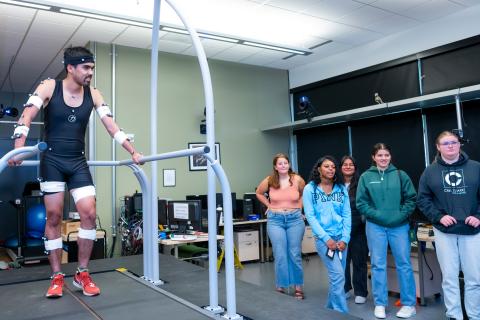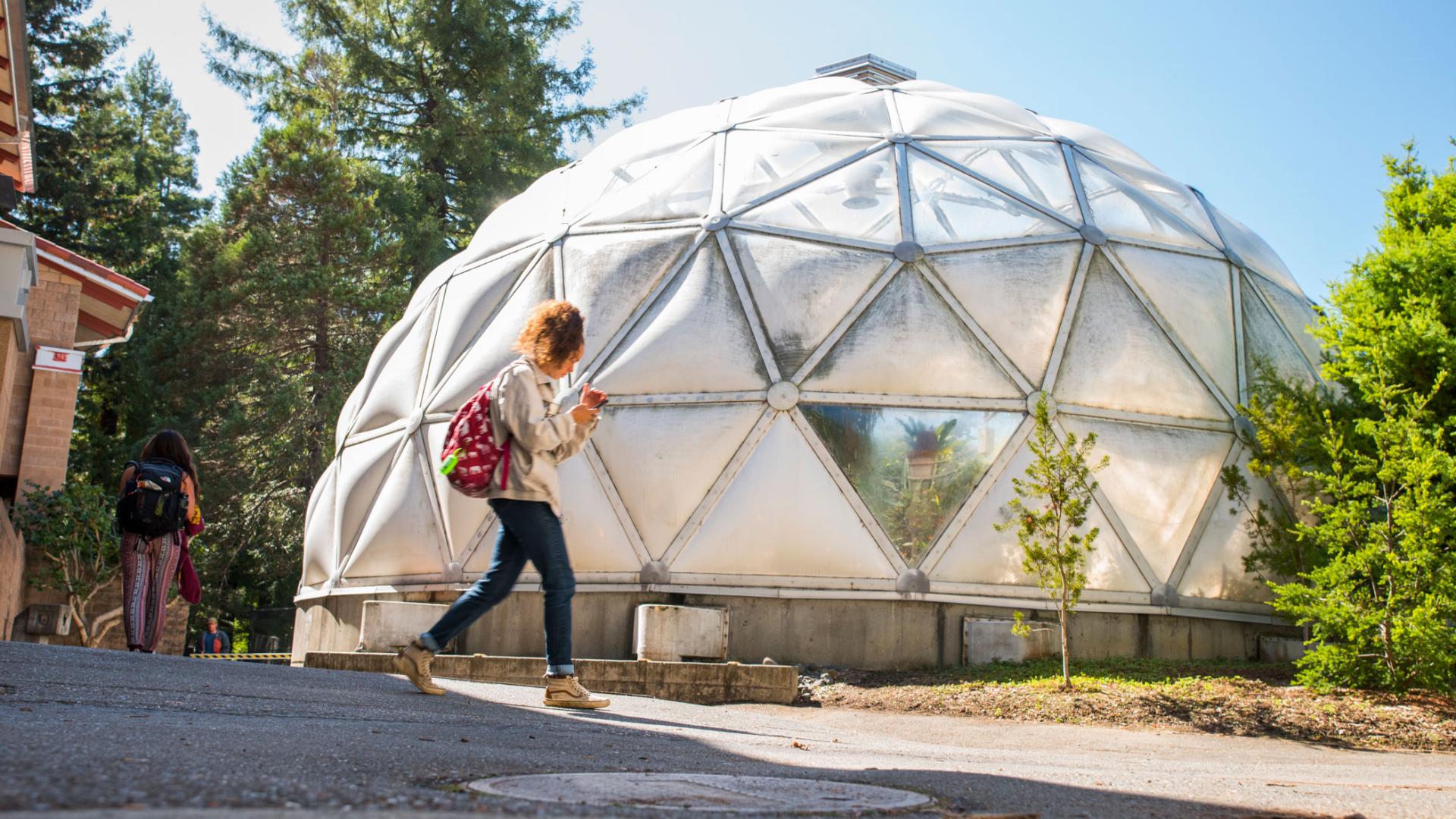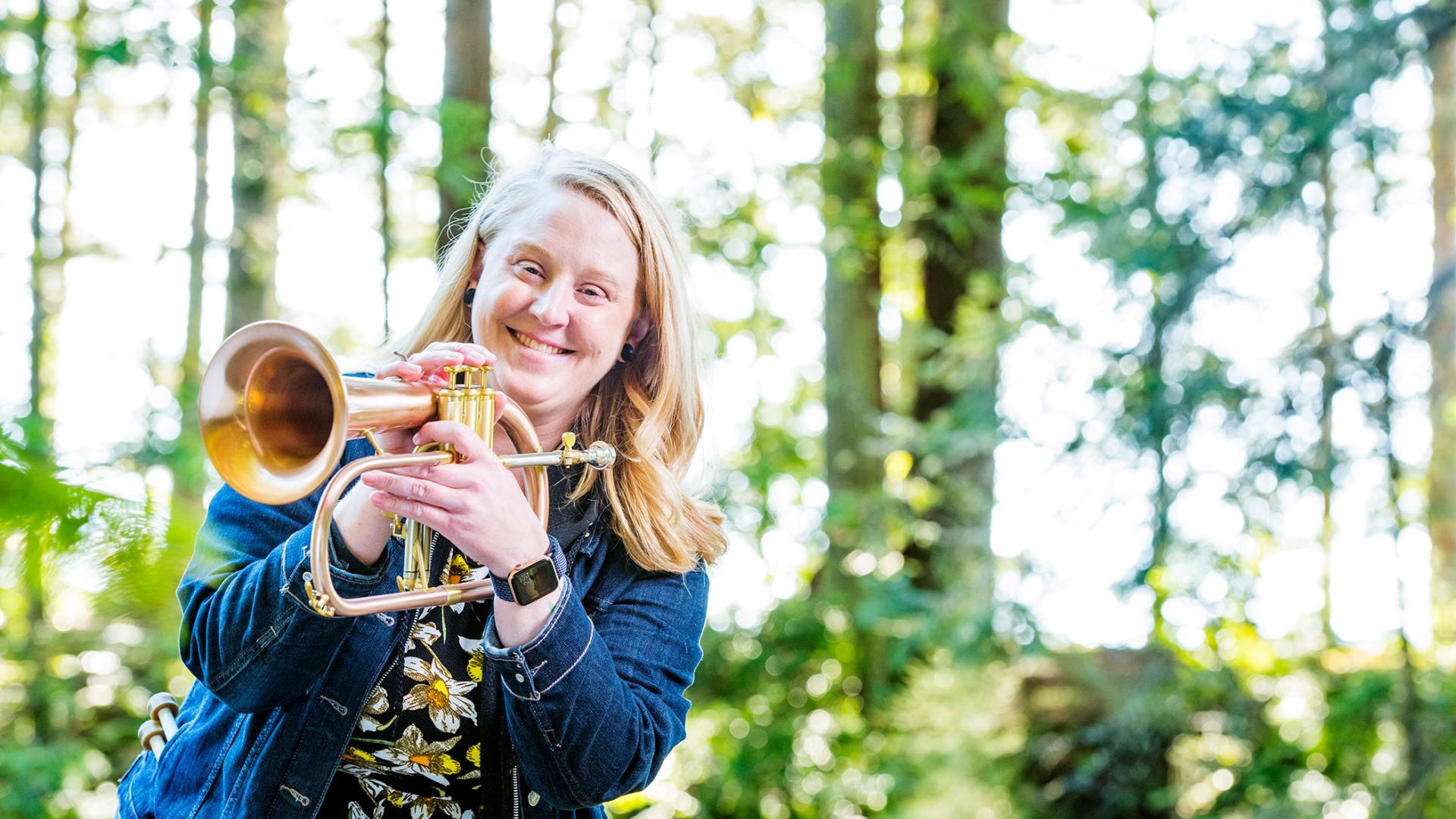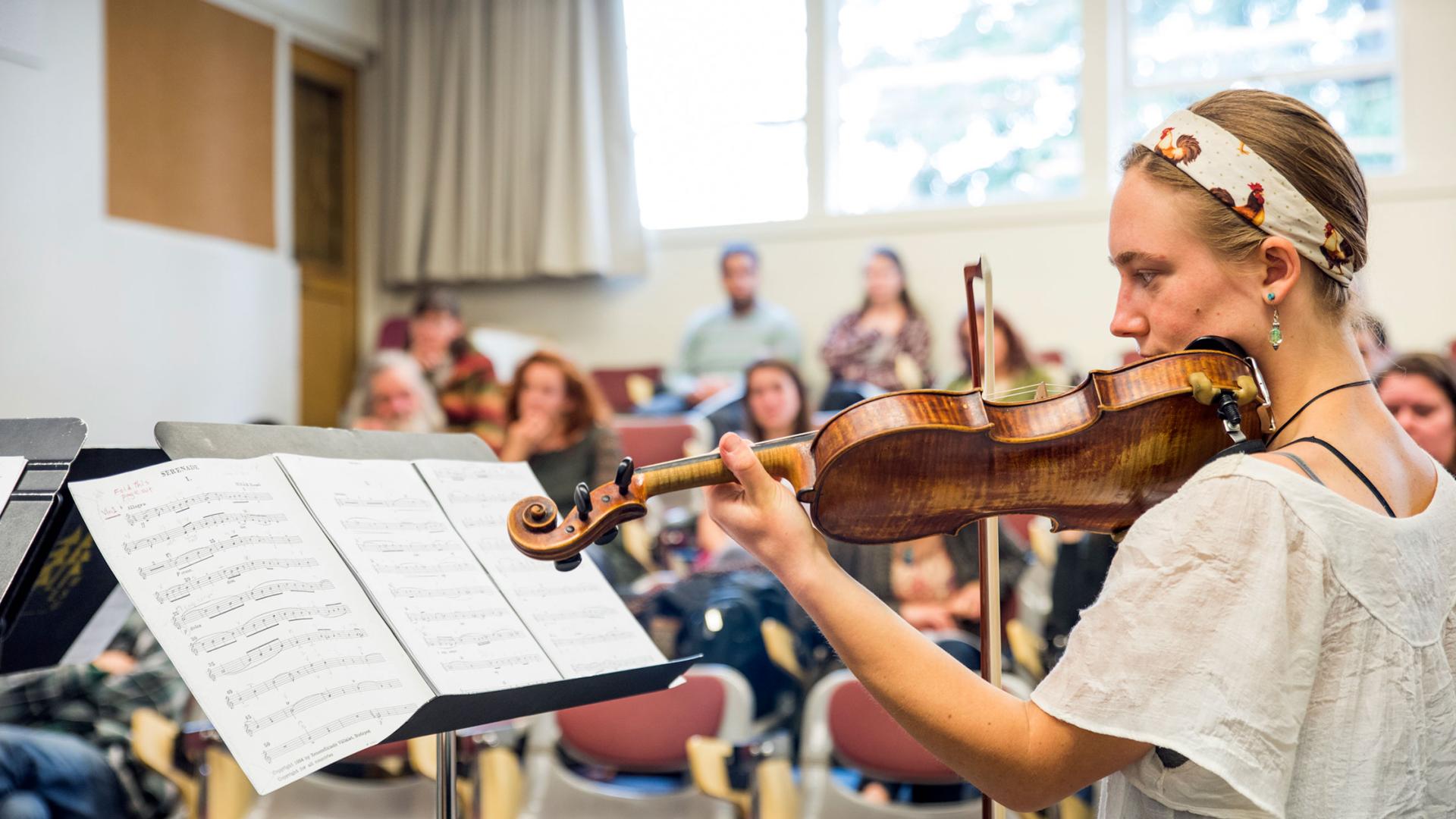Breadcrumb
Biomechanics Lab
Biomechanics is mechanics applied to biology...
(Y.C. Fung, 1981)
Therefor, biomechanics uses expertise from disciplines such as engineering, anatomy, rehabilitation, medicine, orthopedics, and sport science.

Location
Kinesiology and Athletics Building, Room 256B
(Directions)
Phone: 707-826-5973
Fax: 707-826-5451
The Biomechanics Laboratory at Cal Poly Humboldt is a research and learning laboratory affiliated with the Institute of Health and Human Performance.
In the Humboldt Biomechanics Lab, students gain hands-on experience with high-quality biomechanical research methods and techniques. They explore and analyze the mechanical and neuromuscular aspects of human movement while contributing to impactful research and community service. The lab also provides biomechanics and neurocognitive assessments to individuals in the Humboldt area and beyond. As students develop their expertise, they help advance the field by applying and sharing the knowledge they acquire.
Research Interests
- The biomechanics, energetics, and neural control of walking and running.
- Effects of concussion on neurocognitive function and motor control.
Personnel
- North Coast Concussion Program Coordinator: Beth Larson, M.S.
- Lab Manager: Sarah Landis, PT, DPT (sam85@humboldt.edu)
- Collaborators: Justus Ortega, Ph.D. Cal Poly Humboldt; Rodger Kram, Ph.D., University of Colorado Boulder; Stan Lindstat, Ph.D., University of Northern Arizona; Kevin Conley, Ph.D., University of Washington; Massimo Venturelli, University of Utah.
Quick Links
Current Research
Mechanical determinants of walking energetics in older adults (Felperin, Ortega). Muscles must perform at least four functions during walking: (1) Generate muscular force to support body weight; (2) Perform mechanical work to redirect and restore the center of mass velocity during the step-to-step transition; (3) Swing the legs; and (4) Maintain stability. We are performing a series of experiments that manipulate one or more of these functions so as to quantify the cost of each function in normal healthy older adults.
Mechanics and Energetics of Walking in Curved Soled Shoes (Anecito, Ortega). It has been suggested that walking in curved bottom shoes has become popular among fitness enthusiasts. However, little is known about the effects of using curved shoes on the metabolic cost and mechanics of walking. This study investigates the effects of walking in curved shoes on the metabolic cost, inverted pendulum mechanics and mechanical work associated with walking at different speeds.
Effect of mild traumatic brain Injury (mTBI/concussion) on neurocognitive function and motor control (Garcia, LaFarga, Larson, Ortega). Individuals who experience a mTBI are known to exhibit decreases in brain function and motor control. We are performing a series of studies that look at the relationships between neurocognitive function, balance and walking mechanics and how these factors change during concussion recovery.
Effects of age and physical activity on mobility, balance and fall risk in rural and urban dwelling older adults (Alvarado, LaFarga, Ortega). Normal aging is associated with impaired mobility, reduced balance and an increased risk of falls. This series of studies look at how living in rural vs. urban communities influences balance, mobility and fall risk and how different types of exercise may be used to improve balance and mobility and reduce fall risk in older adults.
Effects of immersion physical therapy on balance and mobility in knee osteoarthritis patients (Alvarado, Ortega). Knee osteoarthritis is associated with slower preferred walking speed, increased pain during walking and standing and reduced balance. Recently, water immersion physical therapy has been used in the physical rehabilitation process for these patients. The purpose of this study was to determine the relative effect of immersion therapy and lab-based therapy on balance and mobility in knee osteoarthritis patients.
Effect of mass distribution on energetics and mechanics of walking (Mannatt, Ortega). It has been shown that adding as little as 4 kg of load to the feet substantially increases the energetic cost of walking while adding as much as 20% BW load on top of the head does not increase energetic cost. The purpose of this study is to determine how distributing a load on the body (feet, hip, shoulder or head) influences the metabolic cost and mechanics of walking.
Opportunities for Undergraduates
Requirements for undergraduate students:
- Completed at least one year in college.
- Will be at Humboldt for at least two more semesters.
- Available for 5-10 hours of time per week in blocks of 2-4 hours at a time.
- Kinesiology majors are encouraged.
For more information, contact Sarah Landis (sam85@humboldt.edu).
Unfortunately, due to high demand, we cannot accommodate all qualified students.
Recent Publications
- Venturelli, M and Ortega JD (2013). Skeletal muscle mechanical efficiency does/does not change with age. Journal of Applied Physiology, 114(8):1108-1109.
- Kontos AP and Ortega JD (2011). Neuromotor effects of concussion: A biobehavioral model (p.325-356). In Handbook of Sport Neuropsychology (1st Ed). New York, NY. Springer Publishing.
- Nelson FE, Ortega JD, Jubrias S, Kushmerick MJ, and Conley KE. (2011) A Review: High efficiency in human muscle: an anomaly and an opportunity? Journal of Experimental Biology 214, 2649-2653.
- Frey DJ, Ortega JD, Wiseman C, Farley CT, Wright KP. (2010) Influence of zolpidem and sleep inertia on balance and cognition during nighttime awakening: a randomized placebo-controlled trial. Journal of the American Geriatric Society 59(1):73-81
- Ortega, JD and Farley, CF. (2008) Energetic cost of stability and arm swing in young and elderly adults. Journal of Biomechanics 41(16): 3303-8.
Testing Services
Balance, Mobility and Fall Risk Assessment
These series of tests assess lower body strength and endurance, flexibility, mobility, postural balance, and fall risk. Based on the results of your assessment, we will work with you to find exercises that help to improve your balance and mobility and reduce your risk for falls.
- Individual Appointment at Humboldt: Student/Staff fee: $25 Community fee: $35
- Group Appointment: Student/Staff /Community fee: $15
** PRIOR TO PAYMENT, please call the Biomechanics Lab at 707-826-5973 to schedule an Individual Appointment or Group Testing Appointment (location/times give at time of call).
Clinical Gait Analysis
Static measurements from clinical examination and x-rays are inadequate to assess the subtle dynamic aspects of walking. Clinical observation can be misleading. In order to prescribe effective clinical treatment, more comprehensive information is needed. Gait analysis provides this information by monitoring the skeletal alignment, muscle function, and forces acting on the body during walking. Gait analysis allows accurate assessment of walking function using a series of tests, a variety of sensors, and specialized computer equipment.
Gait Analysis Level 1:
Student/Staff fee: $85 Community fee: $100
Gait Analysis Level 2:
Student/Staff fee: $153 Community fee: $180
Gait Analysis Level 3:
Student/Staff fee: $213 Community fee: $250
3D Movement Analysis Pricing
3DMovement and Forces- $100
3D Movement, Forces, and Muscle Activity- $180
Bike Fit
Student/Staff fee: $85 Community fee: $100
Running Analysis
Do you have shin splints, knee problems or lower back pain from running? Or do you simply want to improve your performance? A running gait analysis can be a useful tool in understanding running injuries and/or improving performance. In the running gait analysis, we use video motion capture and metabolic energy assessment to assist you in determining if you are running in the right shoes, identify changes to your form for reducing injury and improving performance and efficiency.
Running Analysis Level 1:
Student/Staff fee: $42.50 Community fee: $50
Running Analysis Level 2:
Student/Staff fee: $85 Community fee: $100
Running Analysis Level 3:
Student/Staff fee: $153 Community fee: $180
To schedule an appointment, call the Biomechanics Lab.
(707) 826-5973
Facilities
Take a tour!
Located in the Health and Human Performance Institute on the 2nd level of the Kinesiology Building, the Biomechanics Lab occupies approximately 2,000 square feet of general-purpose lab and office space, which is comprised of a biomechanics experimental workspace, neurocognitive assessment/data analysis room, laboratory classroom, computer workstations, subject changing area, and a conference area.
The laboratory has the following equipment available:
- Eight-camera Vicon 3D digital motion capture system
- Three AMTI (OR6-7) force platforms mounted along a 20-m runway
- One Portable AMTI force platforms for balance assessments
- Sixteen-channel Delsys wireless EMG systems
- Uniaxial and triaxial accelerometers
- DartFish 2D video motion capture system
- Trackmaster (TM-55) motorized treadmill
- Two Biopac MP36 stations for EMG, force, and electrogoniometer data collection.
- Uniaxial S-force transducer and hand dynamometer
- Brower Timing system
For data analysis, modeling, simulation, analysis, and presentation the following software is available:
- MATLAB
- Visual3D
- Vicon Nexus
- Polygon
- DartFish
- ImPACT
- Delsys EMGWork
- EndNote
- Sigmaplot
- SPSS
- Biopac Pro
- Microsoft Office Suite (Word, PPT, Excel, Pub)





